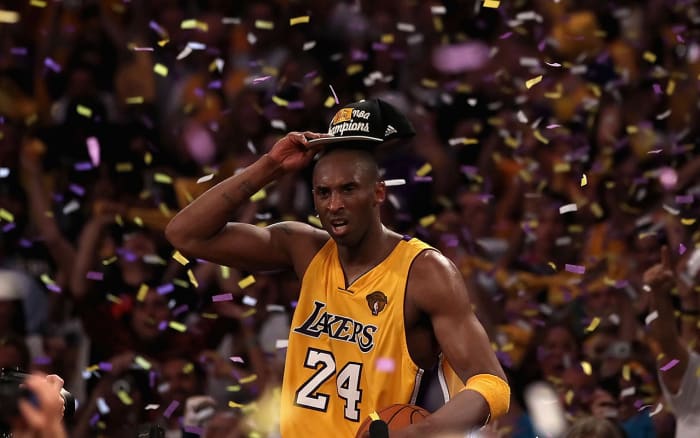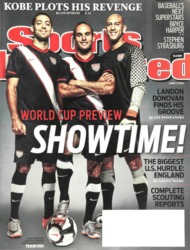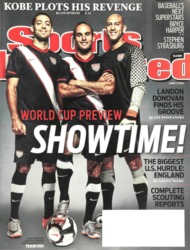Kobe's Final Challenge
The Lakers' bus left TD Garden in the middle of the night, flanked by four policemen on motorcycles, basketball's version of a funeral procession. Inside the bus it was silent, a team shell-shocked by a 39-point horse-whipping to end its season. Outside it was bedlam, a city elated by its first NBA championship in 22 years. The Lakers were heading back to the Four Seasons at the same time revelers were pouring out of Boston bars, causing a human bottleneck in the streets. The bus was forced to stop, and as players and staff members peered out the windows, they noticed a crowd forming around them. One hand slapped the side of the bus, then another, followed by a hailstorm of hands and rocks and bottles. A security guard on the bus rushed for the door to make sure no one tried to open it. Outside, a policeman was knocked off his motorcycle. The bus was rocked back and forth until the driver finally found a clearing and the Lakers were whisked away to suffer in peace.
"It was the kind of thing," says one security official who was onboard, "that nobody forgets."
Least of all Kobe Bryant, with his elephantine memory and preternatural ability to turn failure into fuel. "It's never personal with me," Bryant says with a sarcastic grin, which of course is his way of saying that it's always personal. For a child of the 1980s who joined the Lakers before he was old enough to vote, there was perhaps nothing more personal than the loss to the Celtics in the Finals two years ago, punctuated by the 131–92 blowout in Game 6 and the bus ride in which it was rubbed in his face. "A loss like that," intones former Celtic Bill Walton, "is an indelible stain on the soul." Bryant will not go that far, but after he beat the Celtics at TD Garden in January on a fadeaway jumper with 7.3 seconds left, he mockingly hummed the team's unofficial anthem in the shower: I'm Shipping Up to Boston by Dropkick Murphys. Bryant will now get a second chance to dropkick the Celtics in the Finals, with much more than revenge at stake.
It is hard to imagine that Bryant could be any more beloved in Los Angeles—when the ubiquitous Kiss Cam found actor Dustin Hoffman during the Western Conference finals, he planted a long smooch on his wife, Lisa, only to pull away and reveal a picture of Bryant wedged between their lips—but a victory over the Celtics would take him to Nicholsonian heights. Although several Lakers legends never beat the Celtics in the Finals, Bryant is surrounded by those who did: Kareem Abdul-Jabbar tutors the Los Angeles big men, Magic Johnson is a part owner, James Worthy hosts pre- and postgame TV shows, and Michael Cooper coaches the women's team down the road at USC. They are constant reminders that Bryant probably has at least one more hurdle to clear to become the Greatest Laker Ever. "It's not about beating the Celtics in the regular season," Cooper says. "You have to beat them in the playoffs. That's when you become part of the club."
Bryant has won four championships, and in all of them the Finals were an anticlimax. The more compelling matchups came in the Western Conference playoffs. That will not be the case this time, with Bryant looking for the cherry atop his legacy against the team that makes everything difficult. Boston traditionally double-covers Bryant almost every possession, and there is no reason to change, given that he is coming off the best statistical series of his career—33.7 points, 8.3 assists and 7.2 rebounds against the Suns in the Western Conference finals. Bryant shot 52.1%, remarkable when degree of difficulty is taken into consideration, but as Lakers forward Lamar Odom puts it, "He makes the incredible normal." When Bryant iced the series in Game 6 on a double-clutch, off-balance fadeaway three near the sideline with Grant Hill tucked into his waistband, Suns coach Alvin Gentry said, "Good defense, Grant." To which Bryant replied, "Not good enough," slapping Gentry playfully on the backside.
Bryant most likely won't have many more chances at the Celtics, given their age and, to a lesser extent, his. Bryant is only 31, but NBA stars are like sports cars, in that years do not matter as much as miles. Including the playoffs, Bryant has logged 44,904 career minutes, more than Larry Bird, who played until he was 35. By the time Michael Jordan reached those minutes, he was in Washington. Bryant experienced his first real brush with basketball mortality this season, cloaked as usual in injuries to his back, knee, ankle and hand. He sat out more games than in the previous four years combined. He acknowledged that he lost some elevation. When he scored 12 and 13 points in back-to-back first-round playoff games against the Thunder, a terrifying vision of the future flashed in front of the Lakers' eyes: Kobe Bryant, $30 million-a-year role player. "We were concerned," says Los Angeles director of athletic performance Chip Schaefer, "that he wasn't the Kobe Bryant we've all seen."
Bryant had fluid drained from his knee in the middle of the Oklahoma City series, took a few days off from practice, and then the lift in his legs returned as suddenly as it had vanished. When Bryant refers to himself as "old," stroking the nonexistent stubble on his cheeks, he is being facetious about that as well, a dig at anybody who would believe it. "The notion that I'm old and won't figure things out, that's funny to me," Bryant says. "They should know me better."
Indeed, when Father Time tried to come for him this season, he gave the old guy the middle finger.
When Chuck Person arrived in Los Angeles for training camp, he had never before said a word to Bryant. Person, a former Pacers and Kings assistant, was hired by the Lakers as a special assistant because of his close relationship with the newly acquired Ron Artest. The Lakers wanted somebody to help Artest with his transition. They did not need anybody to help Bryant with his shooting. But Person, who spent 13 years stretching NBA defenses, had studied Bryant's stroke from afar, marveling at his footwork, his vertical leap, his power of separation. "There was just one thing," Person says, "that I felt I could enhance."
A young player is taught, from the time he can lift the ball overhead, to finish the shot with his index finger pointed at the ground. "Kobe was following through with so much of the index that the ball was turning ever so slightly off that finger and he was getting a little sidespin," Person says. "When he wasn't right on, the ball would roll off the rim." Person believed he could help Bryant, but he had to be tactful about it. He could not just walk up to one of the best scorers ever and tinker with his shot. He needed an opening.
On Dec. 11 Los Angeles played the Timberwolves, and point guard Jordan Farmar made a lazy pass to Bryant at the three-point line. Timberwolves forward Corey Brewer lunged for it, deflecting the ball off Bryant's right index finger. Told he had an avulsion fracture, Bryant refused to sit out, and the next night in Utah he missed 17 of 24 shots, including eight of nine three-pointers. The time was right for Person. He approached Bryant and explained that he too had suffered an avulsion fracture in his index finger, with Indiana in 1991. He also told Bryant that the injury presented an opportunity.
"I asked him for his trust," Person says, "and I told him that we should start working together. He didn't argue with me. He bought in right away." Person wanted Bryant to put more pressure on the middle and ring fingers in his release, creating more backspin and friendlier rolls off the rim. The pad Bryant had to wear on the index finger would force him to concentrate on the other two.
The day after the Utah game, Bryant and Person convened early at the Lakers' training facility and shot for one hour before practice. The next day they did the same. Then they flew to Chicago and worked out that night at the United Center. During a break Bryant asked Person, "Did you ever score 40 points with your finger this way?" Person said he did. For Bryant it was a rare moment of self-doubt, and then it was gone. "I'm going to get 50," he said. They arrived at the United Center early the next morning for a shootaround, stayed late, and that night Bryant lit up the Bulls for 42 points on 15-of-26 shooting. A day later he scored 39 in Milwaukee, with a game-winner at the buzzer.
Penetrating Bryant's circle is not easy, but Person had a way in. As a freshman at Brantley (Ala.) High School 31 years ago, Person attended a summer basketball camp at Auburn University. The guest counselor was Jerry West, who as the Lakers executive vice president would bring Bryant from high school to Los Angeles 17 years later. "All the things I told Kobe," Person says, "are things Jerry West told me at that camp." Person persuaded Bryant to raise the ball straight into his shot instead of holding it for a moment at his hip, which has quickened his release; lift his right elbow from nose level to forehead level, which has heightened his arc; and keep that elbow pointed at the basket no matter how his body is contorted. "If you saw a tape of him shooting six months ago," Person says, "it would look completely different."
Many in the organization did not understand why Bryant insisted on playing with the broken finger. He could afford to take time off in December; they needed him healthy in June. As it turned out, playing in December is exactly what prepared Bryant for June. He spent the regular season refashioning his shot in time for the playoffs. The transition was not always easy—his field goal percentage, free throw percentage and three-point percentage all dipped as Person's tinkering intensified—but it was necessary. Although the fracture has healed, Bryant was left with an arthritic knuckle on his index finger that is swollen and painful but appears to affect him not at all. "It's almost helped to some degree," says Lakers shooting coach Craig Hodges. "The index finger is just supposed to hold the ball. The middle finger is supposed to do the work. Look at the net when Kobe shoots now. The ball sinks to the bottom, and 'Pow!' It pops up. That's the backspin he's getting from the middle finger."
Bryant's longevity is a by-product of the many subtle adjustments he has made over the years, starting in 1999, when he broke his right hand and spent all of training camp developing his left. Back then, defenders would dare Bryant to shoot from outside, an unfathomable strategy today. They also tried to lock him up in the post, equally unthinkable. "I don't know any better post player in the game now," West says. Next up for Bryant, says Lakers assistant Jim Cleamons, "he will learn to come off screens so the ball will work for him and he won't have to beat everybody." Bryant's endless improvements require a kind of humility, the best player in the game forever open to the idea that he can get better.
A month ago, it would have sounded preposterous to call Bryant the best, since he had supposedly lost that title to LeBron James. For the second straight season James won MVP, and yet for the second straight postseason Bryant is casting doubt over the validity of those votes. James may dominate winter, but Bryant owns spring. "The perception that the torch has been passed, and somebody else is the best in the game, is what drives him now," says Lakers assistant Brian Shaw. "Especially because he's still playing and the guy who's supposed to be the best isn't."
Bryant recognized as far back as his early 20s that the next generation was gunning for him and he had to stay a few jab steps ahead. In 2000, he spoke at the ABCD basketball camp at Fairleigh Dickinson University in New Jersey, and at one point in his speech a voice shouted from the back of the auditorium, "I could take you one-on-one!" The voice belonged to Lenny Cooke, who at the time was the top-rated high school sophomore in the country, LeBron before LeBron. An hour later, Bryant walked into the gym and sat next to Gary Charles, president of Grassroots Basketball of America. "Where's Lenny?" he asked. Charles pointed to Court 1. Bryant watched closely for 15 minutes, then tapped Charles and told him, "He has nothing for me."
A full decade later Bryant is still fending off the future. He is the Finals headliner, along with Kevin Garnett and Ray Allen and Paul Pierce, crusty thirtysomethings stubbornly resisting the hands of time. The men who keep them going could play as much of a role in this series as the reserves, so it's fitting that the opening salvo was fired by Lakers' longtime trainer Gary Vitti. Last weekend in Phoenix, Vitti was delighted to learn that Crosby, Stills & Nash (another age-defying group) was staying at the team hotel, because the band's road manager happens to be Wayne Lebeaux, who used to be the Celtics' head equipment guy. Vitti convinced the front desk that Lebeaux suffered from a rare skin condition requiring that the temperature in his room be set to a balmy 95°. When Lebeaux checked into his sweatbox, he found a note from Vitti, reminding him in colorful language of the sweltering conditions the Lakers had to endure at the old Garden.
Lakers-Celtics: The heat is back on, and basketball's greatest rivalry is once again at Bryant's fingertips.


